Representing the middle ground between the technological tour de force that is BMW’s flagship 7 Series and the more attainable, people’s choice 3 Series, the weight of expectation borne upon each new 5 Series is significant. The most obvious benefactor of the technologies harnessed in the 7 Series range, the traditionally profitable Five needs to offer not only supreme levels of executive comfort and refinement, but also provide a platform accomplished enough to house the kind of dynamic DNA on which the Bavarian carmaker has built much of its reputation.
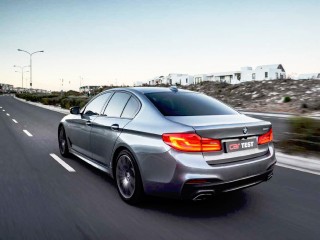
It remains a delicate balancing act. Infuse too much technology to aid comfort and convenience and the corresponding weight penalty becomes an Achilles’ heel as the project nears the M division’s in-tray. Focus too much on dynamic ability and the tradeoff is likely reams of negative press around ride quality and inevitable comparisons against the likes of a certain, always impeccably tailored, rival from Stuttgart.
While in a modern motoring world tech such as adaptive air suspension and intuitive preset driving modes play an ever important role in narrowing the notoriously treacherous field on which the likes of the 5 Series, Mercedes-Benz E-Class, Audi A6 and Jaguar XF play, good sense (and profitable balance sheets) suggests getting the formula right in its simplest form first.
The 5 Series was never going to be the product on which BMW hinges a break in the firm’s aesthetic mould. Consequently, the seventh-generation (G30) Five borrows many of its styling cues from big brother (the G11). Of significance, however, is that these new family lines run deeper than just sheet metal, the 5 sharing much of its lightweight OKL platform (although not the expensive carbon-fibre core structure) with its larger sibling. In addition to a marked improvement in structural rigidity, the resultant weight saving throughout the range sees the new 540i weighing 95 kg less than the equivalent previousgeneration 535i. A corresponding 0,22 Cd drag coefficient sets a new benchmark for this segment.
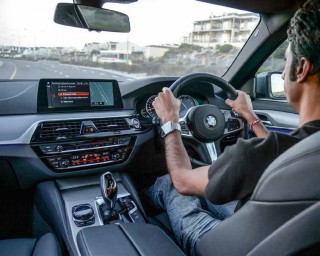
Of the aforementioned increased dimensions, a noteworthy 36 mm stretch in length (to 4 935 mm) translates to greater rear-passenger legroom (including seating for three adults), and a deeper luggage compartment compared with the outgoing Five; both are crucial measurements relating to vehicles in this class.
As the understudy to Seven, the new 5 Series gains many of the driver-oriented technologies and advancements introduced in the flagship; some for better and some for worse. While we remain sceptical about the advantages of gesture control in such a relatively confined environment (especially when it remains more natural to simply use a dash- or steering-wheel-mounted control), other features, including a more intuitive iDrive system linked with a new 10,3-inch touchscreen display, are welcome additions.
While the likes of the E-Class and especially the Volvo S90 offer more contemporary interpretations of facia design, the new 5 Series counters with perceived build quality and levels of cabin refinement that easily match their best-in-class standards.
From a driver’s seat that offers impressive levels of adjustment, to the now-familiar pistol-grip transmission lever and steering wheel-mounted paddles, combined with a larger-than- ever head-up display and even a centre console angled accordingly, there’s little doubt that it’s the driver BMW wants to impress most with the new Five. As such, the standard Driving Experience Control can be switched between eco pro, comfort and sport, the latter priming the electric power steering, transmission, throttle sensitivity and engine mapping for more spirited driving. All models feature an intuitive eight-speed ZF automatic transmission. In the new 540i, this self-shifter is mated with a turbocharged 3,0-litre six-cylinder engine delivering 250 kW and 450 N.m of torque available from a low 1 350 r/min all the way to 5 200 r/min. While this B58- series engine shares similarities with the (2 979 cm3) N55 featured in the previous-generation 535i, the new 2 998 cm3 unit makes use of a larger turbocharger and shares a newly crafted crankcase with its equally brilliant six- cylinder 530d cousin. In the 1 795 kg 540i, this impressive drivetrain is as capable of comfortably negotiating a commute (returning a fuel route figure of 10,2 L/100 km) as it is seeing off hot hatches from the traffic lights (0-100 km/h in 5,30 seconds tested).
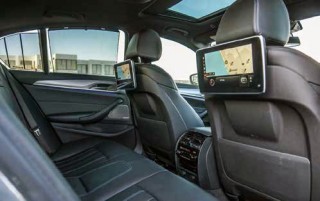
The fact that air suspension is not featured on any options list is a sure sign of BMW’s confidence in its achievements with the all-new suspension setup in the 5 Series. Even when fitted with both an optional M Sport package (including a 10 mm lower ride height) and 19-inch wheels (18s are standard), the new double wishbone front/multilink rear-suspension arrangement on our 540i test unit impressed with both its finesse in everyday driving conditions and composure once pushing on (even without the optional – R39 800 – Adaptive Drive system, incorporating fast-acting, electronically controlled anti-roll bars).
While a compliant ride is a welcome addition to the 5 Series’ breadth of talents, it still boasts the 50:50 weight distribution front to rear, impressively flat cornering prowess and pin-point precise steering that are hallmarks of the built-in dynamic ability inherently infused into all BMWs.
The optional, uprated M Sport braking system fitted to our test unit proved its worth by returning an excellent average emergency-stopping time from 100 km/h of just 2,78 seconds.
TEST SUMMARY
Despite the pressure placed on this particular segment by the unbridled popularity of the highriding SUVs, the current crop of executive sedans, including the Volvo S90, Mercedes-Benz EClass, Jaguar XF, Lexus GS, Audi A6 and now the new BMW 5 Series, remain shining examples of just how far each of these manufacturers has come over the course of their respective timelines.
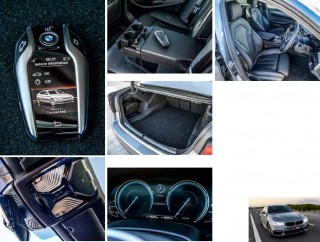
While it’s easy to get lost within the technological highlights of each competitor in this segment, what makes the 5 Series the new benchmark is its impressive breadth of ability. It’s large enough to transport five adults and their luggage in cossetting comfort, while remaining nimble enough to raise pulses, regardless of which engine option is ticked.
What the 540i represents is a compelling argument against both the price tag and inevitable comfort compromises that the likes of the forthcoming V8- powered M5 will offer. Yes, the hallowed M badge will always draw attention, but the appeal of the 540i is that it offers genuine performance and handling prowess in a relatively low-key package that’s just as happy navigating an urban environment as it is setting a mountain pass alight.
What’s even more encouraging is that the few members of the CAR team who’ve sampled the 530d claim that it is even more accomplished than the model tested here. So, as impressive as the new 540i is, there’s a strong possibility that the best is yet to come.
Price: R990 316
0-100 km/h: 5,30 sec
Power/Torque: 250 kW/450 N.m
Top speed: 250 km/h
CAR fuel index: 8,64 L/100 km
CO2: 164 g/km
The new segment leader, but with a caveat: the 530d is even better / Terence Steenkamp
Can’t afford an M5? This will do nicely / Wilhelm Lutjeharms
Brilliantly accomplished, both in terms of refinement and performance / Ian McLaren
USED OPTION 2 yrs BMW M5 There’s no denying the menacing sense of purpose this turbocharged 412 kW M car exudes. Because it’s the older F10 model, prices for two-year-old examples are dipping under R1 million.
Clockwise from top Neat attention to detail inside; eco pro mode offers a drivetrain focus on minimal consumption; front seats boast impressive support and comfort; updated iDrive system includes large touchscreen.
The drivetrain is as capable of negotiating a commute as it is seeing off hot hatches.
Clockwise from top Comfortable rear seating for three adults … or two and their drinks; luggage capacity is best in class; smart key ownership can prove cumbersome due to the sheer size of the fob. opposite Exterior lines link the new Five closely with the current 7 Series.
FEATURES CHECKLIST
Airbags: front/side/curtain/knee Air-con: dual-zone climate Audio system: radio/CD/MP3/aux-in/Bluetooth/voice control Cruise control: standard adaptive Sat-nav: std Park assist: std Windows: all-elec. Trip computer: std Folding rear seat: optional 60:40 Upholstery: leather Driver seat adjust: manual incl. height Iso x anchorages: outer rear Steering adjust: rake + reach Steering audio controls: std Tyre sensors: std Wipers auto-on: std Headlamps auto-on: std
MATCH-UP
BMW 540i STEPTRONIC G30
Price R990 316
Cylinders/capacity (cm3) 6/2 998
Power (kW/r/min) 250/5 500-6 500
Torque (N.m/r/min) 450/1 380-5 200
Gears/drive 8/R
0-62MPH / 0-100 km/h (sec) 5,30
Max speed (km/h) 250
Fuel index (L/100 km) 8,64
Luggage capacity (L) 392/1 016
Service/maintained plan M5/100 000 km
OUR VERDICT
Specced carefully to avoid a hefty bill, the 540i impresses with its overall levels refinement, excellent drivetrain and genuine split personality. Why wait for the M5?
MERCEDES-BENZ E400 4MATIC 9G-TRONIC
price R1 006 126
cyl/capac (cm3) V6/2 996
power (kW/r/min) 245/5 250
torque (N.m/r/min) 480/1 600
gears/drive 9/4
0-100 km/h (sec) 5,20 est
max speed (km/h) 250
fuel index (L/100 km) 10,10
luggage capac (L) 360/856
serv/maint plan M6/100 000 km
OUR VERDICT
The all-wheel-drive E400 neatly bridges the gap between the accomplished E63 AMG and its refined, yet relatively docile stablemates. AWD superfluous here, though.
JAGUAR XF 35t R-SPORT
Price R1 120 492
cyl/capac (cm3) V6/2 995
power (kW/r/min) 250/6 500
torque (N.m/r/min) 450/4 500
gears/drive 8/R
0-100 km/h (sec) 5,40 est
max speed (km/h) 250
fuel index (L/100 km) 10,20
luggage capac (L) 256/856
serv/maint plan M5/100 000 km
OUR VERDICT
Remains a compelling, if pricey, alternative to the Germans. Matches the BMW on dynamic ability, but perceived build quality lags behind the German vehicles’.
SPECIFICATIONS
ENGINE Cylinders six, inline, longitudinal
Fuel supply electronic direct fuel injection, turbocharged, intercooled, petrol
Bore/stroke 82,0/94,6 mm
Cubic capacity 2 998 cm3
Compression ratio 11,0 to 1
Valvegear d-o-h-c, four valves per cylinder
ENGINE OUTPUT
Max power ISO (kW) 250
Power peak/Red line (r/min) 5 500-6 500/7 000
Max torque (N.m) 450
Torque peak (r/min) 1 380-5 200
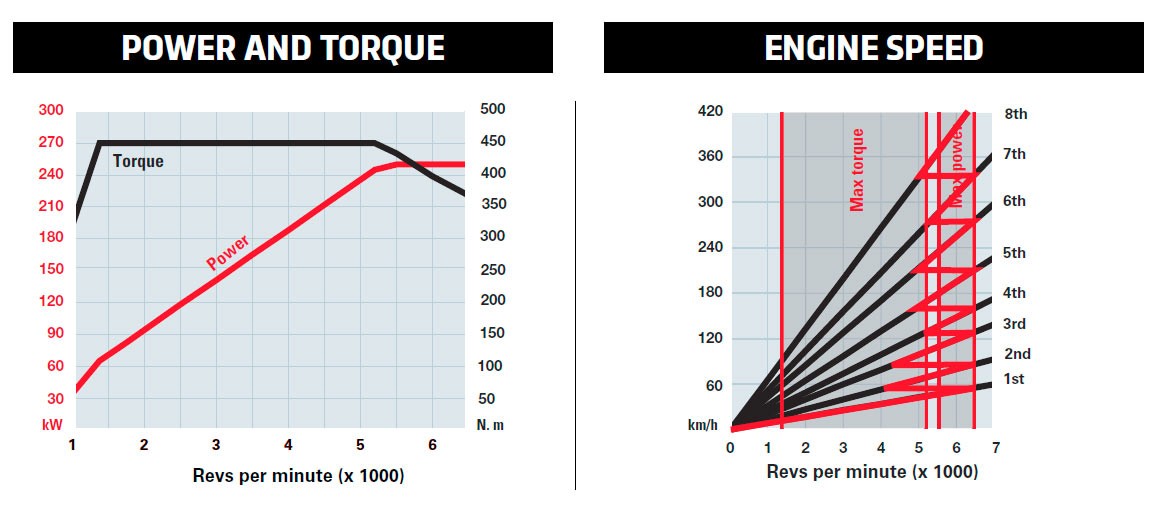
TRANSMISSION
Type eight-speed automatic ZF 8HP
1st gear/2nd gear 5,00/3,20 to 1
3rd gear/4th gear 2,14/1,72 to 1
5th gear/6th gear 1,31/1,00 to 1
7th gear/Top gear 0,82/0,64 to 1
Reverse gear 3,46 to 1
Final drive 2,92 to 1
Drive wheels rear
Driver aids ESC (Electronic Stability Control)
BRAKES
Front 374 mm ventilated discs
Rear 345 mm ventilated discs
Hydraulics ABS with EBD and EBA
WHEELS AND TYRES
Tyre make Michelin Primacy 3
Tyre size 245/40 R19 (f); 275/35 R19 (r)
Spare – type and location none, mobility kit
STEERING
Type rack and pinion, electric power assist
Lock to lock 3,0 turns
Turning circle diameter 12,1 m
SUSPENSION
Front independent, double wishbone, coil springs, anti-roll bar
Rear independent, multilink, coil springs, anti-roll bar
WARRANTY & SERVICE INTERVALS
2-year/unlimited km warranty
5-year/100 000 km maintenance plan
Services according to onboard computer
PARTS PRICES (incl. VAT)*
Oil lter R258,15
Air lter R567,56
Left headlamp R39 677,96
Left rear tyre R5 139,00
Windscreen R9 737,88
Brake pads (front set) R4 907,47
Camchain (incl. tensioner) R2 598,37
Total parts basket R62 886,39
*Prices as recommended by manufacturer
TEST RESULTS
MAXIMUM SPEED (km/h)
Manufacturer’s figure 250
Speedo calibration 60 80 100 120
True speed 58 77 97 116
Odometer error 0,05% over
ACCELERATION (seconds)
0-60 0-80 0-100 0-120 0-140
2,77 3,89 5,30 7,06 9,18
OVERTAKING ACCELERATION (seconds)
AT
40-60 1,03
60-80 1,19
80-100 1,55
100-120 1,81
120-140 2,80
FUEL CONSUMPTION:
Manufacturer’s figure 7,20 L/100 km
CAR fuel index 8,64 L/100 km
Fuel route 10,20 L/100 km
Estimated tank range 787 km
Taxable CO2 rating 164 g/km
BRAKING TEST
10 stops from 100 km/h measured in seconds.
Best/worst stop 2,63/2,89
Average of 10 stops/rating 2,78/excellent
Average stopping distance 37,54 m
PERFORMANCE FACTORS
Power/mass (W/kg) 139
Power/litre (kW/litre) 83
Torque/litre (N.m/litre) 150
Engine speed (at true 120 km/h in top gear (r/min)) 1 806
Cabin noise level at idle (dBA) 40
TEST CONDITIONS
Altitude at sea level
Ambient temp/barometric press 26 °C/1 012 hPa
Test car’s odometer 5 320 km






